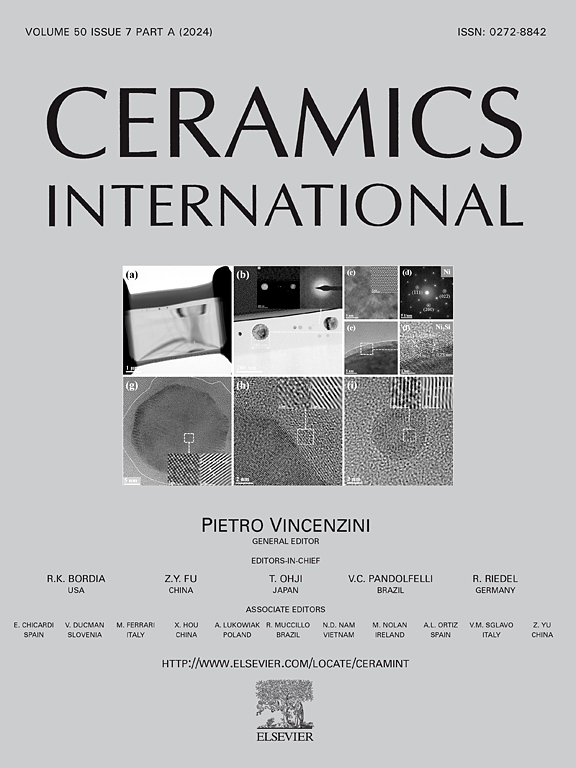Enrichment of strontium and magnesium improves the physical, mechanical and biological properties of bioactive glasses undergoing thermal treatments: New cues for biomedical applications
IF 5.1
2区 材料科学
Q1 MATERIALS SCIENCE, CERAMICS
引用次数: 0
Abstract
Bioactive glasses (BGs) have emerged as invaluable resources for bone tissue engineering due to their remarkable properties such as bioactivity, resorbability, cell compatibility, and osteoconductivity. However, these materials exhibit certain limitations when subjected to high temperatures, for their tendency to crystallize, thus leading to diminished bioactivity, reduced mechanical strength, and altered dissolution kinetics. One promising approach to counteract this problem is to reduce the alkaline element content in BGs while simultaneously adding strontium and magnesium. Building on previous studies of Bio_MS, a recently developed experimental formulation, we investigated the contributions of strontium and magnesium to the thermal, mechanical, and biological properties of various bioactive glasses, including commercially available options. Differential thermal analysis, heating microscopy, X-ray diffractometry, environmental scanning electron microscopy, measurement of the Young's modulus, simulated body fluid testing, cytotoxicity tests, cell viability, growth, adhesion and morphology were assessed through an integrated approach and compared for a complete evaluation of BGs, and of doped BGs, also undergoing thermal treatments. The results demonstrated improved thermal, mechanical and biological behaviors of the magnesium-strontium-doped BGs, thus paving the way for the development of BGs with enhanced biomedical perspectives.
富集锶和镁可改善热处理生物活性玻璃的物理、机械和生物特性:生物医学应用的新线索
生物活性玻璃(BGs)具有生物活性、可吸收性、细胞相容性和骨传导性等显著特性,已成为骨组织工程的宝贵资源。然而,这些材料在高温条件下会表现出一定的局限性,因为它们容易结晶,从而导致生物活性减弱、机械强度降低和溶解动力学改变。解决这一问题的一个可行方法是减少 BGs 中的碱性元素含量,同时添加锶和镁。在之前对最近开发的实验配方 Bio_MS 的研究基础上,我们研究了锶和镁对各种生物活性玻璃(包括市售选择)的热、机械和生物特性的贡献。我们采用综合方法对差热分析、加热显微镜、X 射线衍射仪、环境扫描电子显微镜、杨氏模量测量、模拟体液测试、细胞毒性测试、细胞活力、生长、粘附和形态进行了评估,并对生物活性玻璃和掺杂生物活性玻璃(同样经过热处理)进行了全面的评估比较。结果表明,掺镁锶的 BGs 在热学、机械和生物学行为方面都有所改进,从而为开发具有更好生物医学前景的 BGs 铺平了道路。
本文章由计算机程序翻译,如有差异,请以英文原文为准。
求助全文
约1分钟内获得全文
求助全文
来源期刊

Ceramics International
工程技术-材料科学:硅酸盐
CiteScore
9.40
自引率
15.40%
发文量
4558
审稿时长
25 days
期刊介绍:
Ceramics International covers the science of advanced ceramic materials. The journal encourages contributions that demonstrate how an understanding of the basic chemical and physical phenomena may direct materials design and stimulate ideas for new or improved processing techniques, in order to obtain materials with desired structural features and properties.
Ceramics International covers oxide and non-oxide ceramics, functional glasses, glass ceramics, amorphous inorganic non-metallic materials (and their combinations with metal and organic materials), in the form of particulates, dense or porous bodies, thin/thick films and laminated, graded and composite structures. Process related topics such as ceramic-ceramic joints or joining ceramics with dissimilar materials, as well as surface finishing and conditioning are also covered. Besides traditional processing techniques, manufacturing routes of interest include innovative procedures benefiting from externally applied stresses, electromagnetic fields and energetic beams, as well as top-down and self-assembly nanotechnology approaches. In addition, the journal welcomes submissions on bio-inspired and bio-enabled materials designs, experimentally validated multi scale modelling and simulation for materials design, and the use of the most advanced chemical and physical characterization techniques of structure, properties and behaviour.
Technologically relevant low-dimensional systems are a particular focus of Ceramics International. These include 0, 1 and 2-D nanomaterials (also covering CNTs, graphene and related materials, and diamond-like carbons), their nanocomposites, as well as nano-hybrids and hierarchical multifunctional nanostructures that might integrate molecular, biological and electronic components.
 求助内容:
求助内容: 应助结果提醒方式:
应助结果提醒方式:


